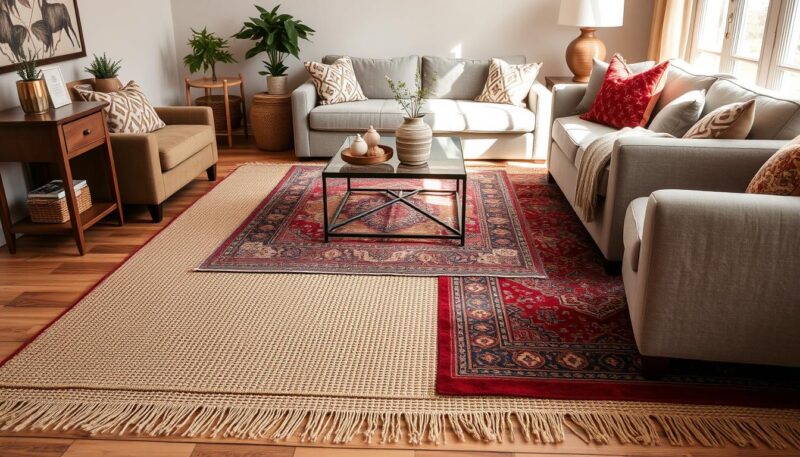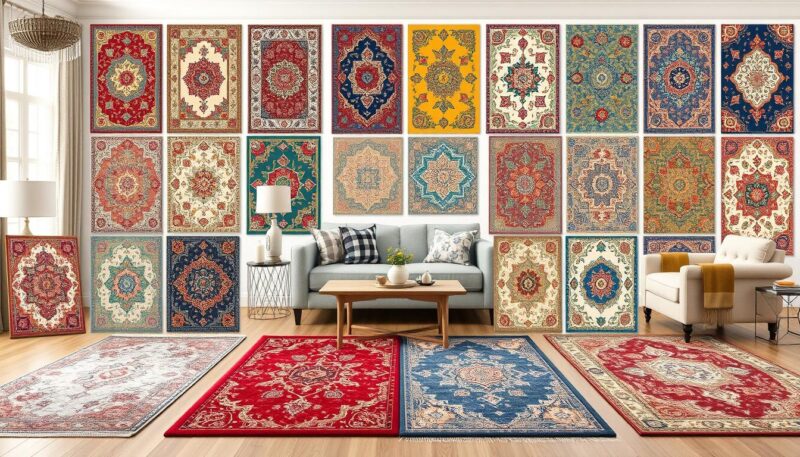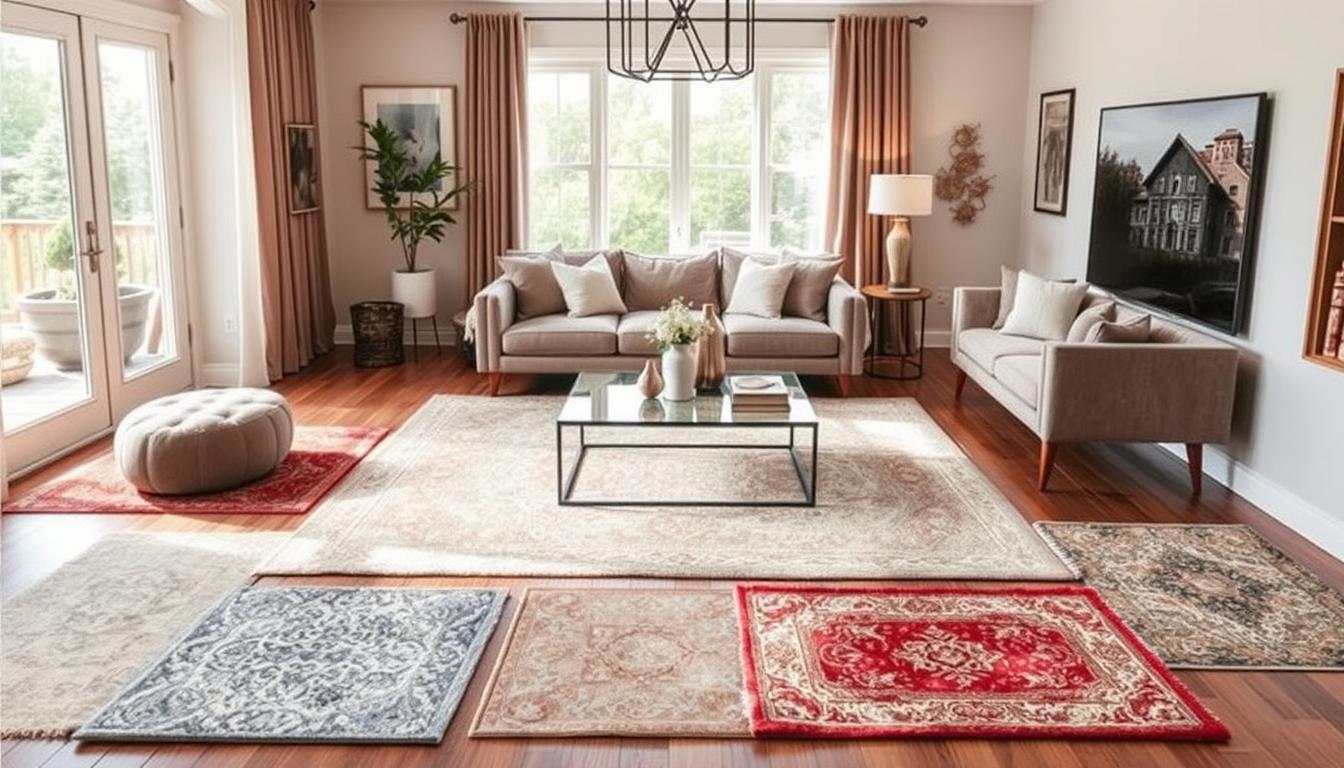Creating a cozy and visually appealing living room starts with choosing the right rug size. Whether you’re furnishing a new space or refreshing an existing one, getting the rug dimensions just right can make all the difference in achieving a cohesive and balanced look. In this comprehensive guide, we’ll walk you through the steps to accurately measure your living room and find the ideal rug size to complement your furniture layout and personal style.
From common rug measurements to layout ideas and essential considerations, we’ve got you covered. By the end of this article, you’ll be equipped with the knowledge to select a rug that fits your space like a glove, maximizing both functionality and aesthetic appeal.
Key Takeaways:
- Typical living room rug sizes range from 8’x10′ to 9’x12′.
- Consider the width of your sofa and allow at least 6″ (8″ ideal) of rug on each side.
- Maintain a walkway of 30″ to 36″ between large furniture pieces, or at least 18″ to 24″ if space is limited.
- Experiment with different rug layouts, such as “All Legs On Board” or “Front Legs Only,” to find the perfect fit.
- Explore layering rugs and unconventional shapes to create a unique and visually interesting space.
Determining the Ideal Rug Size Based on Living Room Dimensions
Choosing the right rug size is crucial for anchoring your living room and creating a cohesive, visually appealing space. To help you narrow down your options, we’ll provide a rug sizing chart for different living room dimensions. Typical living room rug sizes are 6’x9′, 8’x10′, and 9’x12′.
Rug Sizing Chart for Different Living Room Sizes
| Living Room Size | Recommended Rug Size |
|---|---|
| Small (~ 150 sq ft or 10’x15′) | 6’x9′ |
| Medium (~ 200 sq ft or 12’x18′) | 8’x10′ / 9’x12′ |
| Large (~ 300 sq ft or 15’x20′) | 9’x12′ |
In general, living room rugs should typically be 8’x10′ or 9’x12′ to create a balanced and cohesive look. Smaller 6’x9′ rugs may work in smaller living rooms, but can appear too small if the space is larger.
Common Rug Layout Ideas for Your Living Room
- Place the front legs of your furniture on the rug to anchor the space
- Have all furniture legs on the rug for a seamless, cohesive look
- Layer a smaller rug, such as a 5’x8′, over a larger rug for visual interest
- Use a small “floating” rug in front of the sofa or coffee table
- Position a larger rug at an offset angle to create a dynamic, asymmetrical layout
These rug layout ideas will ensure your rug effectively grounds the living room and creates a harmonious, well-designed space.
Rug Size for Living Room – Key Considerations
When selecting the perfect rug for your living room, it’s not just about measuring the room’s dimensions. Balancing furniture proportions and ensuring proper rug placement are equally important considerations. By understanding the key rules for rug size and layout, you can create a cohesive and comfortable living space that showcases your style.
Balancing Furniture Proportions with Rug Size
The rug size should be proportional to your living room furniture. As a general guideline, the rug should be at least 8-10 inches wider than your sofa on both sides. This helps to anchor the sofa and create a visually balanced look. Additionally, the coffee table should be 40-60% the width of the rug, ensuring it doesn’t appear too small or overwhelm the space.
| Room Size | Recommended Rug Size |
|---|---|
| Small Living Room (150 sq ft) | 6’x9′ |
| Average Living Room (200 sq ft) | 8’x10′ or 9’x12′ |
| Large Living Room (300 sq ft) | 9’x12′ or larger |
Ensuring Proper Rug Placement and Walkway Clearance
Proper rug placement is essential for creating a harmonious living room layout. The rug should be positioned to leave 24-36 inches of clearance between furniture pieces, ensuring comfortable walkways. This allows for easy movement around the room without feeling cramped or cluttered.
- Leave at least 24 inches of clearance between furniture pieces
- Ensure 18 inches of space between the rug and surrounding walls
- Consider leaving 1 inch of space from grates and radiators for safety
By balancing furniture proportions and ensuring proper rug placement, you can create a living room that is both visually appealing and functional. Take the time to measure your space, consider your furniture layout, and explore common rug size guidelines to find the perfect fit for your home.
https://www.youtube.com/watch?v=CGrgNXnq_Ac
Creating a Cohesive Look with Layered Rugs
Rug layering is a fantastic way to add depth, texture, and visual interest to your living room. By strategically placing a smaller rug on top of a larger base rug, you can create a cohesive and stylish look that elevates the overall design of your space.
When layering rugs, the top rug should be about two-thirds the size of the bottom rug. This helps maintain a balanced and proportional appearance. The bottom rug, typically a large size like 10×14 or 9×12, should encompass the primary furniture area of the room.
For the base rug, consider natural materials like chunky jute with tassels, hand-woven jute with wool fringe, or a diamond-patterned natural jute. Neutral tones like gray and navy stripes can also work well as a foundation.
Top off the layered look with a fluffy, textured rug, such as an ivory wool Moroccan shag or a natural shag with tassels. You can also introduce pops of color and pattern with accent rugs like pink Persian, blue vintage tapestry, or turquoise overdyed Oriental medallion designs.
Typically, two rugs are the optimal amount for a cohesive layered look, though you can experiment with up to three. Rug layering is a trend that has gained popularity in recent years, allowing you to transform a room without overpowering the overall design.

Remember, when layering rugs, it’s important to consider the placement and leave a gap between the rug edges and the room’s walls. Ideally, the furniture should rest on the rug for a seamless, integrated appearance.
Rug layering is a versatile and cost-effective way to add depth, texture, and visual interest to your living room. By experimenting with different materials, colors, and patterns, you can create a truly unique and cohesive look that reflects your personal style.
Exploring Color and Pattern Options for Living Room Rugs
Beyond the size of your living room rug, the color and pattern you choose can significantly impact the overall aesthetic of your space. Whether you prefer a neutral, muted palette or bold, statement-making designs, there are a variety of options to consider that can elevate your living room’s style.
Coordinating Rug Colors with Existing Decor
When selecting a rug color, it’s important to coordinate it with your existing living room decor. Take note of the dominant hues in your furniture, walls, and accessories, and choose a rug that complements or contrasts them in a visually appealing way. Neutral tones like beige, gray, or ivory can provide a versatile foundation, while pops of color in the rug can add vibrancy and personality to the room.
Choosing Patterns for Visual Interest and Style
Rug patterns can also play a significant role in setting the tone of your living room. Opt for a solid, textured rug to create a cozy, grounded feel, or explore patterned options like stripes, geometric designs, or intricate motifs to add visual interest and a unique touch to your space. Consider the overall style of your living room, whether it’s modern, traditional, or somewhere in between, and select a rug pattern that complements that aesthetic.
By carefully considering the color and pattern of your living room rug, you can create a cohesive and visually striking space that reflects your personal style and complements your existing decor. Experiment with different options to find the perfect rug that ties your living room together in a beautiful and functional way.

“The right rug can truly transform a living room, adding depth, texture, and a personal touch to the space.”
Maximizing Functionality and Style with Living Room Rug Materials
When selecting a rug for your living room, the material is a crucial factor to consider. The right rug material can not only enhance the overall style of your space but also provide the necessary durability and easy maintenance for high-traffic areas. Let’s explore some of the best options that can help you strike a balance between rug functionality and rug style and durability.
Durable and Easy-to-Clean Options for High-Traffic Areas
For living rooms that see a lot of foot traffic, it’s essential to choose rug materials that can withstand the wear and tear while maintaining their appearance. Two top contenders in this category are wool and nylon.
- Wool Rugs: Wool is a natural, durable fiber that is highly resistant to stains, crushing, and fading. Wool rugs are easy to clean and can last for years, making them an excellent choice for high-traffic living rooms.
- Nylon Rugs: Nylon is a synthetic fiber that is known for its exceptional durability and stain resistance. Nylon rugs are a practical option for active households, as they can withstand heavy use and are simple to maintain.
Both wool and nylon rugs offer the functionality required for a busy living room while allowing you to explore a wide range of styles and designs to suit your decor preferences.
| Rug Material | Durability | Ease of Cleaning | Maintenance Requirements |
|---|---|---|---|
| Wool | Highly Durable | Easy to Clean | Moderate |
| Nylon | Highly Durable | Easy to Clean | Low |
By considering the rug materials that offer both functionality and style, you can create a living room that is not only visually appealing but also well-equipped to handle the demands of everyday life.
Conclusion
By following the guidelines and considerations outlined in this guide, you’ll be able to find the perfect rug for your living room that not only fits your space, but also complements your style and ensures lasting functionality. From determining the ideal size based on your room dimensions to coordinating colors and patterns, you now have the tools to create a cozy, cohesive, and visually appealing living area that reflects your unique taste.
Whether you’re looking to anchor your furniture arrangement, define different zones within an open-plan layout, or add a touch of personality to your décor, the key is to strike a harmonious balance between the rug size, your living room dimensions, and your design preferences. By paying attention to details like furniture proportions, walkway clearance, and maintenance needs, you can maximize the functionality and style of your living room rug.
With the wealth of rug options available, from classic to contemporary, solid to patterned, and natural fibers to synthetic materials, the possibilities are endless. By embracing the concepts of finding the perfect living room rug, rug sizing and layout tips, balancing functionality and style, and creating a cohesive space, you’ll be well on your way to transforming your living room into a warm, inviting, and visually captivating oasis that reflects your personal style.
FAQ
What are the common living room rug sizes?
Typical living room rug sizes are 6’x9′, 8’x10′, and 9’x12′.
What are some common rug layout ideas for a living room?
Common rug layout ideas include placing the front legs of furniture on the rug, having all furniture legs on the rug, layering a smaller rug on top of a larger base rug, and using a small floating rug.
How do I ensure the rug size is proportional to my living room furniture?
The rug should be at least 8-10 inches wider than your sofa on both sides, and the coffee table should be 40-60% the width of the rug. Proper rug placement is also essential, leaving 24-36 inches of clearance between furniture pieces for comfortable walkways.
How can I use layered rugs to create a cohesive look in my living room?
Layering rugs is a great way to add depth and visual interest. You can use a large base rug with a smaller rug placed on top, or position a layered rug at an offset to the base rug.
How do I choose rug colors and patterns that complement my living room decor?
Coordinate rug colors with your existing decor, and choose patterns that add visual interest and complement your living room’s style, whether you prefer neutral tones or bold, statement-making designs.
What rug materials are best for high-traffic living rooms?
Consider durable and easy-to-clean options like wool and nylon, which can provide long-lasting performance without compromising the overall aesthetic of your living room.
Source Links
- https://stylebyemilyhenderson.com/blog/living-room-rug-size
- https://www.realsimple.com/how-to-choose-the-right-rug-size-7505727
- https://froy.com/blogs/tips/how-to-pick-the-right-rug-size-for-your-living-room?srsltid=AfmBOorA-uZWyYw1SpO0qiaWlJNUIRLg7etvx7uPWpO_QMsUwy5UgDmn
- https://loomyhome.com/blogs/resources/rug-size-guide?srsltid=AfmBOoppRMzfRhC17BRo_aV_uHPuLUxaAanzBxQXMx6w8cyUowP5fz4p
- https://froy.com/blogs/tips/how-to-pick-the-right-rug-size-for-your-living-room?srsltid=AfmBOoql2wSxqNKQiahhve6Cx_avbFtpyWom4A6Uf204SL8mUy8aZ4Oa
- https://loomyhome.com/blogs/resources/rug-size-guide?srsltid=AfmBOorWUecmsBKaCnCasVVnZnVepjQuAuvHxH1VPguL0Pz8qu7xQ1_8
- https://www.makingjoyandprettythings.com/create-perfect-layered-rug-look/
- https://gatheraus.com/house-home/a-simple-guide-to-the-layered-rug-look
- https://www.stonegableblog.com/how-to-layer-rugs-like-a-pro/
- https://ruggallery.net/blogs/rugs/rug-size-for-living-room-comprehensive-guide?srsltid=AfmBOoo4D1LZ5X7jBbFXNwwusjvHW9arMwnH4lJA0LwPEJmwXmUUprqR
- https://froy.com/blogs/tips/how-to-pick-the-right-rug-size-for-your-living-room?srsltid=AfmBOopyn_mk5iXLdbLgyklipBUWbSpXuC_4qsXa_9Vr937fQP_LcHdl
- https://theambiente.com/blog/living-room-rug-size-guide-find-the-perfect-fit-for-your-space/?srsltid=AfmBOoqKMwDf6kaVebWGBmgK3EIeGgG-GwKH4NK3v1QTJ37wX46yuJqK
- https://www.shadesoflight.com/blog_entries/rug-placement-buying-guide-for-each-room
- https://www.hearthsidefurniture.com/blog/post/how-to-place-a-rug-in-living-room?srsltid=AfmBOopbnWb9zJsTnKf1BJW1AeX_RF3H4Q1O7i8VkR_0sl2YBihtKaSs
- https://ruggallery.net/blogs/rugs/rug-size-for-living-room-comprehensive-guide?srsltid=AfmBOooIU_HIQ2Bcb1KpD8QKrqiu-FmjVSUyHTKXR1lT9Iwc-TU7yHHW
- https://www.vertuliving.com/blogs/news/rug-size-for-living-room?srsltid=AfmBOorcllnSRGdhnK67xLTOM2dqZgMa_xICqbIIcBHQQ8LhdKnuW-xd
